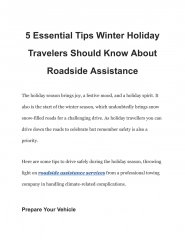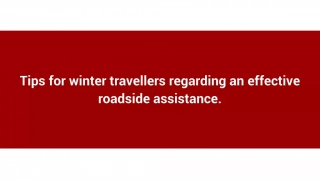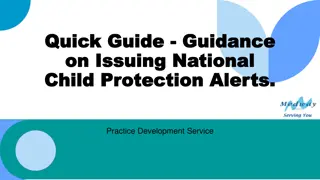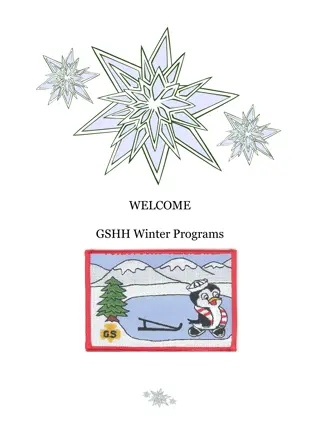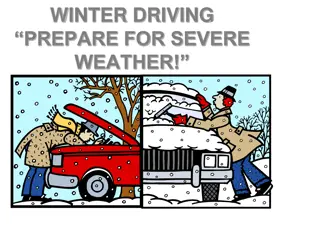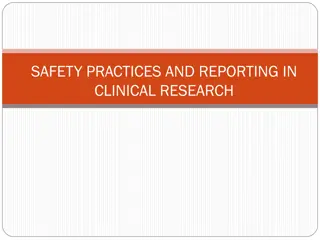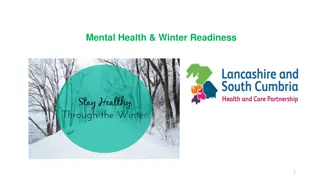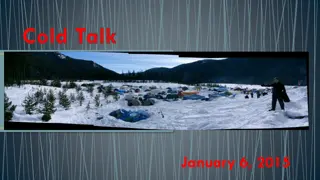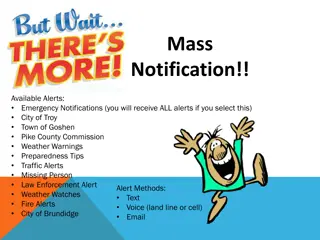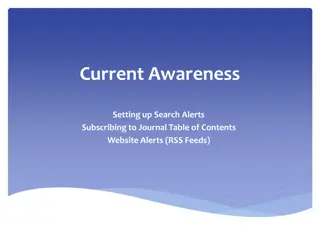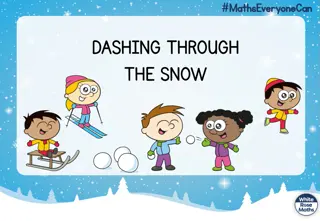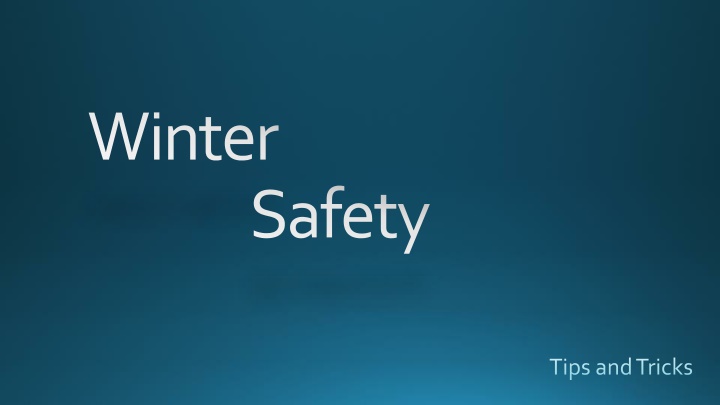
Essential Winter Safety Tips and Alerts
Canadian winters can turn dangerous quickly. Learn about different weather alerts, precipitation risks, and cold alerts to stay safe outdoors. Explore the importance of staying informed and prepared during the winter season.
Download Presentation

Please find below an Image/Link to download the presentation.
The content on the website is provided AS IS for your information and personal use only. It may not be sold, licensed, or shared on other websites without obtaining consent from the author. If you encounter any issues during the download, it is possible that the publisher has removed the file from their server.
You are allowed to download the files provided on this website for personal or commercial use, subject to the condition that they are used lawfully. All files are the property of their respective owners.
The content on the website is provided AS IS for your information and personal use only. It may not be sold, licensed, or shared on other websites without obtaining consent from the author.
E N D
Presentation Transcript
Winter Safety Tips and Tricks
Canadian Winters Spending time outdoors can be beneficial to good health, both mentally and physically But Canadian winters can become dangerous quickly, with little warning Winter storms and excessive cold, claims more than 100 lives each year in Canada Environment and Climate Change Canada issues numerous severe weather alerts to notify the public when there are upcoming weather changes These alerts allow the public to plan ahead and stay safe in the event of an emergency These alerts may include extreme cold, blizzards, ice storms, along with transitions between weather types There are four types of alerts issued, depending on the severity and the timing of the weather events
Four Types of Weather Alerts Warning: is updated routinely and identifies that severe weather is either impending or currently occurring Watch : identifies a potential for severe weather and can be upgraded to a warning as the weather system evolves Advisory: identifies less severe weather, such as blowing snow, fog, freezing drizzle, and frost. This weather can still impact Canadians Special Weather Statement: this alert is the least urgent of the alerts and identifies when unusual weather conditions may occur that could currently impact your surroundings or potential incoming weather events
Fall and Winter Weather Alerts Precipitation Cold Poor visibility **There are also generic warnings and advisories that occur that have no suitable warning type because they are unique and rare weather occurrences
1. Precipitation Alert Includes Snowfall: involves significant snowfall Snow squall: is identified when cold air moves across large, open bodies of water (ie. Great Lakes) and creates slow moving bands of snow and cloud Freezing rain/ freezing drizzle: this occurs when rain and drizzle land on sub-zero surfaces and freezes, causing ice to form on the surface Rainfall: involves significant rainfall Winter storm: is generally issued when various types of severe weather are expected to occur simultaneously
2. Cold Alerts Arctic outflow: is any combination of wind speed plus temperatures which provide a wind chill of -20 degrees or lower for 6 hours or more Extreme cold: can be issued with extremely cold temperatures or with very low wind chill values Flash freeze: is issued when there is a sudden drop in temperature which causes excess surface water/ slush on sidewalks and streets to suddenly freeze
3. Poor Visibility Blizzard: warning is issued when winds are expected to create blowing snow and reduced visibility of 400 metres or less Blowing Snow: is issued when winds are expected to create reduced visibility of 800 metres or less to occur
What is a Wind Chill? A wind chill is cold air with accompanying winds = wind chill Wind chill is used to determine how quickly the wind causes heat loss Wind chill is important, especially if you are required to work outside https://www.ccohs.ca/oshanswers/phys_agents/cold_working.html
Frostbite Frostbite is where the skin and deeper tissue (fat, muscle etc.) is frozen Check areas such as your face, ears, nose, cheeks, hands, and feet for the following signs and symptoms: white, waxy texture, cold, numb, hard to the touch What to do get medical help, the frozen area may need an amputation, do NOT rub the area, do NOT warm the area until you are sure you can keep it warm, avoid direct heat and warm slowly
Hypothermia Hypothermia is where the core body temperature drops after prolonged exposure to the cold. Your body is losing heat faster than it can generate heat. Signs and symptoms include shivering, confusion, difficulty moving and loss of coordination (walking, talking, etc.), when shivering stops, the body s core temperature has dropped to life threatening levels What to do get the person indoors or into a shelter, remove any wet clothing, warm them up slowly, put the individual in a lying position **Get help immediately if you notice signs of confusion, slurred speech, stiff muscles, or uncontrollable shivering
Staying Warm Wear layers of clothing with a wind-resistant outer layer Remove layers before you begin sweating Add layers if you begin getting cold Wear warm socks, mittens, hat, and scarf In extremely cold conditions, cover exposed skin If you get wet, change into dry clothing (you lose heat faster when you are wet)
Winter Driving Colder temperatures, snow, and ice can cause dangerous road conditions Roads can be slippery with the potential for decreased road visibility There could be unseen hazards such as black ice, fog, slush, and ever-changing road conditions which make driving hazardous
Winter Driving Safety Slow down (leave sufficient space between vehicles, do not break when turning or going around a corner, never slam the brakes on snow and ice, instead pump the brakes or down shift if you drive a standard vehicle, if you do slide, do not touch the gas or the breaks, allow the tire traction to grip the ice, look and steer where you want to go) Winter Tires (improves traction so you can stop and turn easier in cold weather, check your vehicle s tire pressure monthly, as tire pressure decreases in colder temperatures) Extra windshield fluid (fluid should be for -40C range, and reservoir in the vehicle should be full) Gas tank (keep fuel tank at least full when parked-when driving, have more fuel than you think is necessary) Visibility (clear all the snow off your vehicle, top, hood, trunk, all windows, and lights, any piece of snow or ice can become a projectile when driving) Check your windshield wipers and ensure to clear the ice and snow off them as well
Less-Practiced or Known Driving Tips Check the weather forecast, allow for extra travel time Don t rely on GPS: add an extra 15 minutes to your driving time so you don t have to rush. Wear your seatbelt: this seems obvious but more than a quarter of drivers and passengers who were fatally injured in a collision, were not using a seatbelt Turn on your lights: this allows you to see and other driver s to see you! Put your phone away and make sure it is charged for your journey Don t use cruise control: stay attentive and be ready to brake, drive at safe speeds (remember speed limits are posted for ideal weather) Stay calm if you get stuck: Don t try pushing or lifting your vehicle yourself, ensure your tailpipe is not blocked with snow (prevent carbon monoxide poisoning), keep your window slightly open for fresh air and to remain awake
Safety and Planning Ahead When there is a blizzard warning, stay indoors and wait until it ends. If you do need to go outdoors, dress appropriately. In extreme blizzards tie one end of a long rope to your door and hold onto the other end to avoid getting lost. If you need to shovel, start slow and take your time to avoid over-exertion. Develop a storm readiness plan which may save valuable time in an emergency An emergency pack should include a battery-powered flashlight, a radio, tools for emergency repair, ready-to-eat foods, a first aid kit, blankets, and extra clothing Keep your gas tank or generator full Keep some cash on hand in case the power goes out
7 Steps for Cold Weather Preparation Listen to weather forecast before leaving your place-https://weather.gc.ca/canada_e.html Plan ahead limit time outdoors, move activities inside, schedule warm-up breaks, dress appropriately Dress warmly layers, have wind resistant outer layer, wear hat, mittens, scarf, waterproof footwear, cover as much exposed skin as possible Seek shelter with significant wind chills limit time outside and get out of the wind when possible Stay dry wet clothing causes body to cool quickly, remove layers to prevent sweating and remove wet clothing as soon as possible Keep Active moving (walking or running) will generate heat and keep you warm Be aware of frostbite and hypothermia signs, elderly and children are more sensitive to the cold
Emergency Car Kit Includes Food that won t spoil such as energy bars Water in plastic bottles so it wont break if it freezes (change every 6 months) Blanket Spare shoes/ boots and clothing First aid kit with seat belt cutter Candle (in a deep can) and matches Whistle Flashlight (crank) Road maps Copy of your emergency plan
Emergency Trunk Kit Includes Salt, sand, or cat litter (non-clumping) for extra traction Antifreeze or windshield washer fluid Tow rope Jumper cables Fire extinguisher Warning lights or road flares
What to do Before a Storm Before/Preparation Tie down or remove lose items garbage cans, lawn furniture Create a 72hr emergency kit see link for video on how to create a 72 hr emergency kit https://www.youtube.com/watch?v=5yk3dsC2Fkc
During a Storm Stay inside If you need to go outside, wear mittens, toque, jacket that is water-repellent and has a hood If you have to travel, let someone know your plans, when you are leaving, where you are going and when will you return If you get stuck, crack a window, and turn on the car for 10minutes every 1/2hr. keep the exhaust free from blockage to avoid carbon monoxide poisoning. Exercise hands and feet to keep the blood circulating Stay away from windows, doors, and fireplaces Use cellphone not landline if required
After a Storm Remain calm Check self and others for injuries Only use phone for emergencies, keep the lines open for officials to use Do not turn off utilities unless you suspect they are damaged Do not light a fire until you have checked for gas leaks (smells like rotting eggs) Water supplies might be contaminated, boil or purify first Do not go near downed power lines, they can cause fires and harm to people If the power has been off for a few hours, check the fridge for food spoilage
Winter Walking Tips Use good pair of winter boots well insulated, waterproof, light weight, non-slip tread Ice grippers to increase traction on snow and ice, REMOVE before walking on hard flat surfaces such as stone, tile and ceramics Cane or ski poles to increase balance Wear bright and reflective clothing to increase visibility for drivers and other walkers Wear hat, scarf, mittens, and layers to help slow heat loss
Walking on Ice Slow down and think about your next move Keep feet wider apart to increase balance Keeps knees and body lose Take small steps, or shuffle feet https://canadasafetycouncil.org/safety-tips-for-winter-walking/
Outdoor in the Winter Check weather before going out Wear layers, hat, mittens, waterproof outer layer, waterproof insulated boots Wear sunscreen, the sun reflects on the snow and can still burn skin Keep hydrated Monitor for frostbite and hypothermia Elderly, children, and those with circulation issues are affected by the cold quicker than others
Indoor Safety Keep your home warm (keep your heat sources properly cleaned and managed; always use the correct fuel recommended by manufacturer; never burn paper, green wood, or pine branches indoors; winterize with sound insulation and weather stripping) Do NOT use gasoline or kerosene heaters indoors as they may explode Invest in a dry-chemical fire extinguisher Don t forget to wash your hands to stay safe, especially if you are sharing items like pens or toys, coughing, or blowing your nose
Indoor Safety To prevent death by fire, make sure your smoke alarms work Test the smoke alarm every month push the test button, if there is not test button, it is outdated and you need a new one Twice a year, change the batteries even if it has not been used Clean your smoke alarm ever 2 years Replace your smoke alarm every 10 years Get a carbon monoxide detector too and take care of it the same way you would a smoke alarm https://www.thepersonal.com/blog/-/winter-safety-tips
Winter and Kids Supervise those younger than 8 years old, buddy system should be used for older children Dress children in warm clothing Remove strings and cords from clothing so your child doesn t get caught on playground equipment, in doors, on sleds; ensure to tuck the ends of a scarf into the child s jacket; attach mittens with clips instead of a long string to avoid getting caught Stay indoors when wind chill is -27C or lower, exposed skin begins to freeze Take regular breaks indoors for warm drinks and clothing changes Clothing should include layers, a hat that covers ears, mittens, and warm waterproof boots Keep hydrated and eat enough food Consider safety equipment and safe practices with winter activities such as toboganning, skiing, snowboarding, and skating (practice what you preach)
Resources 5 Tips for Safe Winter Driving https://www.canadadrives.ca/blog/driving-tips/driving-tips-for-winter-in-canada Be Prepared to Stay Safe and Healthy in Winter by the CDC https://www.cdc.gov/nceh/features/winterweather/index.html#:~:text=Take%20 Precautions%20Outdoors&text=Wear%20appropriate%20outdoor%20clothing% 3A%20wear,precautions%20to%20follow%20when%20outdoors. Copy of emergency plan -link to creating emergency plan https://www.getprepared.gc.ca/cnt/plns/mk-pln-en.aspx
Resources Safe Winter Driving Tips https://www.caa.ca/driving-safely/winter-driving/safe-winter-driving-tips/ https://www.ccohs.ca/oshanswers/safety_haz/icesnow.html Staying Warm and Safe in Canadian Winters Health and Safety Tips from the Canadian Red Cross: http://casey.ca/wp-content/uploads/2019/12/Winter-Health-and-Safety- Tips.pdf
Resources Ice thickness and other safety tips https://www.aboutkidshealth.ca/Article?contentid=1954&language=English https://www.thepersonal.com/blog/-/winter-safety-tips https://www.safetyandhealthmagazine.com/topics/1147-seasonal-safety- winter https://www.parachutecanada.org/en/injury-topic/winter-outdoor-safety/
Resource Winter Safety Tips by the National Safety Council https://www.nsc.org/community-safety/safety-topics/seasonal- safety/winter-safety/winter Comprehensive Winter Safety Resource https://www.atlantictraining.com/safety-tips/winter-safety-tips.php
References https://www.aboutkidshealth.ca/Article?contentid=1954&language=English#/ https://www.canada.ca/en/environment-climate-change/services/seasonal-weather-hazards/be-prepared- for-winter.html https://www.ccohs.ca/oshanswers/phys_agents/cold_working.html https://skprevention.ca/safety/winter-safety/ https://www.getprepared.gc.ca/cnt/rsrcs/sfttps/tp201002-eng.aspx

